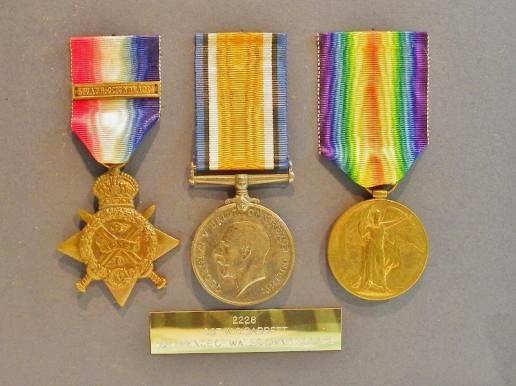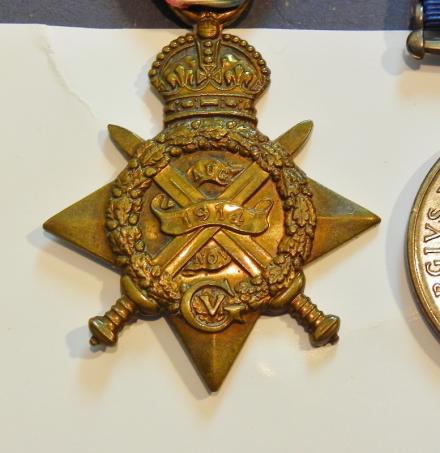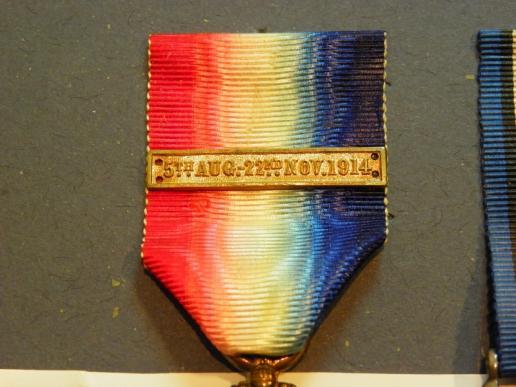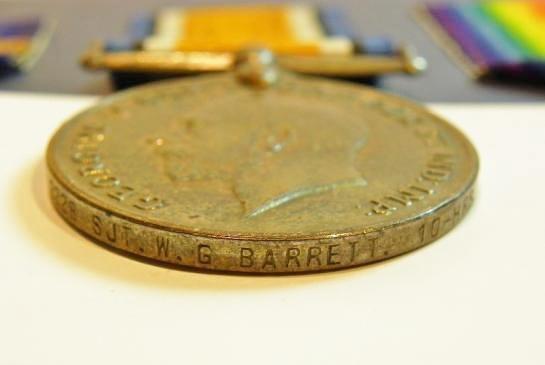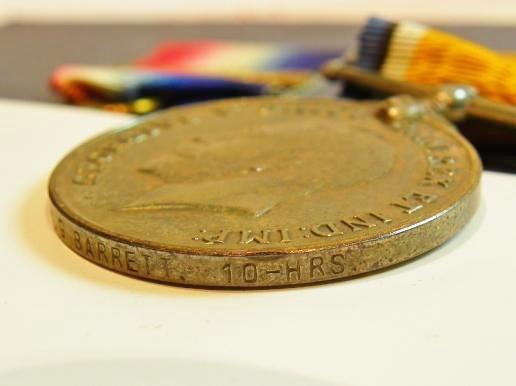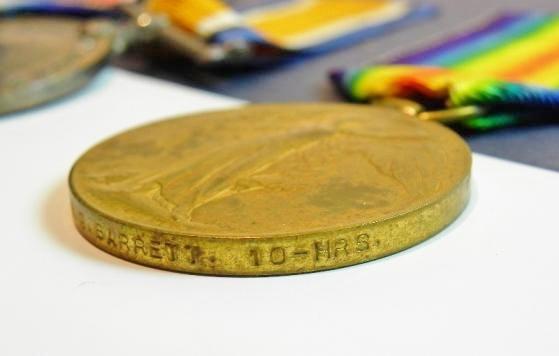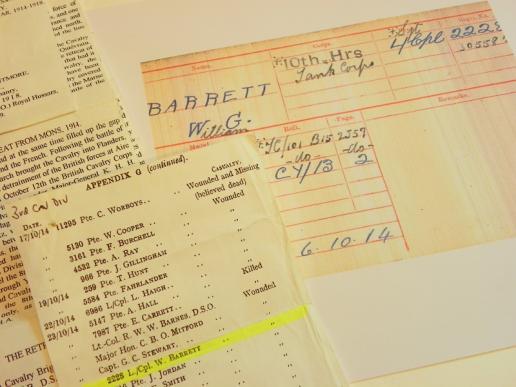Scarce Mons Star Trio to Cpl/Sjt Barrett 10th Hussars / Tank Corps
A superb WW1 trio comprising of the 1914 star with the August to November Mons bar. The WW1 British war and victory medal; all correctly named to 2228 Serjeant (Corporal on star) William. G. Barrett. Of the 10th Prince of Wales Own Hussars.
This trio comes with various research including a copy of his mic and the 10th Hussars war diary on Cd Rom in pdf format. William Barrett served with the 10th Hussars until the introduction of the Tank Corps when Barrett was transferred to the new unit, but a brief history of 10th Hussars and Serjeant Barrett’s service can be found below.
William Barrette boarded HMS Bosnia from Southampton on the 6th October 1914, bound for Ostend. His shop docked during the night of the 8th and the 10th Hussars gradually came ashore and by 9am on the 9th October, they were ready to be assigned billets.
On the 13th October they were on the march to Ypres with the 6th Cavalry Brigade, on rout it was reported that one Bavarian cavalry division was spotted at Warneton. 20,00 all arms at Tournai, 20,00 at Hazebrouck and heavy fighting reported at Lille and the Germans were bombing that town.
On the 19th the regiment was ordered to advance east at Ledegham, ‘A’ squadron to the advance guard and ‘B’ the baggage guard. They drove the enemy to the outskirts of the village. The enemy received strong reinforcements and the cavalry was forced to retire. The next day the regiment took up a defensive line with the 7th brigade and the French cavalry running south from Westoozebeke, but once again they were forced to retire. Either on the advance of the 19th or the defensive action of the 20th, William Barrett was wounded. I do not know to what extent, but he must have made a full recovery as he returned to his regiment.
With the establishment of trench warfare, the Regiment couldn’t be used in a traditional cavalry role for parts of the war. The 10th Hussars were in and out of the front line trenches and suffered a constant stream of casualties. The 10th Hussars took part in the Battle of Frezenburg Ridge at the Second Battle of Ypres and suffered heavy casualties on the last day of the battle, 13th May 1915; these casualties amounted to 138 officers and men and included their Lieutenant-Colonel.
In the September 1915 they took an active part in the battle Loos 26th to the 28th of September and although most of the historic accounts say that the 10th didn’t really take part in any engagements during 1916 the regimental diary says different. They didn’t take part as a regiment, but the men and horses were used in all different rolls, many were subbed out to the machine Gun Corps, the horses used to carry Lewis guns. At this time, the regiment was constantly receiving reinforcements, and subsequently these reinforcements needed training. It was probably around here, Corporal Barratt was promoted to Serjeant. He would have been of great use for training the new arrivals, ready for the battle of Arras, which was the next major engagement for the 10th.
Orders were received on the 9th April 1917, “to saddle up at once” and move to the Arras area, here to take part in the attack on Monchy le Preux.
The 10th set off on the 9th of April up near the front line ready to advance on orange Hill and found the infantry had not yet arrived. Here they halted for a few hours, dismounting and watering the horses in the river Scarp.
At 2.30 am on the morning of the 10th, the moved back along the main Arras road about 1 Km west of Arras and tethered the horses in a nearby field. At 10.30am they again got orders to advance to the first objective, orange hill, this they did, but again were halted, the infantry had not advanced to attack Monchy-Le-Preux. At 3pm, Lieutenant Lord W Scott took a patrol through heavy machine gun fire, to try and find out the situation and located the infantry coming up behind with the remainder of the brigade. The 10th were ordered to push on around the side of Orange hill but came under a crossfire of machine guns. The squadron wheeled about trying to find another route to their objective but met, the diary says; “with high explosives being wield”, this was probably a barrage of grenades. The squadron met with very heavy casualties, men and horses and were only saved by a very heavy snow storm coming on at that moment. At 8pm the whole brigade moved back just north of Feuchy Chapel.
The next day, the brigade was given the task to advance, seize and hold the high ground villages and woods, east side facing the river Scarp. The 10th Hussars along with the Essex Yeomanry charged, meeting heavy machine gun fire coming from the north of the Scarp canal. Still both regiments continued forward despite heavy casualties. Reaching the outskirts of the villages, they again hit heavy machine gun fire, but undeterred the 10th followed the Essex Yeomanry to the centre of Monchy-Le-Preux. They then turned due north until reaching the outskirts of the village. On emerging from the village, they were face with another enemy machinegun emplacement, it was now quite apparent that the infantry were not holding the villages and were pin down in a nearby Chateau. Soon after the remainder of the two regiments arrived in the village, they were met with German artillery, but behind them came our machine guns, Hotchkiss’s and automatic rifles.
189 men of the 10th fell that day, who knows how many horses, remarkably Serjeant Barrett wasn’t one of them.
Their numbers were diminished, so the rest of 1917 was spent in and out of trenches, receiving new recruits and training. 1918 saw the brigade in action again at the Battle of St Quentin 21st to 23rd March, but between 22nd and 25th March 1918 the Division provided the 3rd Dismounted Division, organised into three dismounted brigades. It also provided a mounted detachment under “Harman’s Detachment” and then “Reynolds’s Force” between 23rd and 29th March.
Here I am going to stop with the accounts of the 10th Hussars, it seems logical that at this point Serjeant Barrett would have transferred to the Tank Corps. It, in my opinion, couldn’t have been any earlier, or his medal pair would have been named to the later regiment. And, as now the regiment is totally dismounted, here seems likely.
The 10th went on to the German Spring Offensive, and during 1918, the 10th Hussars also took part in the Hundred Days Offensive and suffered 70 casualties during the attack on the village of Honnechy on 9th October 1918. (Oops couldn’t help myself)
Weather Barrett saw any action with the Tank Corps, I do not know, as there was still plenty of fighting to come, he probably did. He survived, he was one of the blessed; he lived to receive his trio and probably, hopefully wore them with pride.
All of the online regimental histories tell a very different story to the one in the original war diary. It leads me to think, that no one has actually read through this edifying document. Yes this regiment was dismounted and fought as infantry on occasions in the early and latter part of the war, but the bulk of their action, they saw on and with their horses. These actions were fierce and bloody and should not be in any way taken away from them.
The medals are in excellent original condition. a few minor contact marks from the star on the BWM, but nothing that could be considered as damage.
They now come nicely mounted on card for display or framing with an engraved brass plaque with the medals detail.
Code: 22904
Code: 25211

